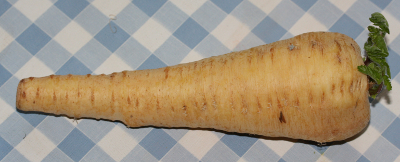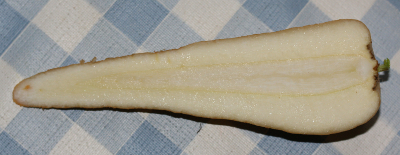Parsnip |

Root of the parsnip

Longitudinal section through the root
Possibly the wild type came from the Mediterranean region. When, where and how the first useful plant was bred from it, unfortunately remains in the dark. The parsnip appears in Central Europe around 1400 AD. After that, it was treated regularly in various herbals.
The confusion of parsnips and carrots in the New Herbal of Leonhart Fuchs (1501–1566) can be seen. He distinguished between two races of parsnips: The "Groß zam Moren" (large tame carrots) and the "Wild Moren" (wild carrots) that would differ only in size. There were many dissected leaves at the stem and at the top there were beautiful yellow flowers that would leave a wide seed. The taste of the roots would remind yellow turnips, by that he meant those plants, today we call carrots. Looking at his chapter about carrots, he describes them as "zahme Pastenachen" (tame parsnips), where he distinguished a yellow and a red variety.
The long forgotten vegetables, which was about 1800 superseded by the more flavorful orange carrot and by the higher-yielding potato, today going through a renaissance as a part of the ecology movement. The vegetables, that should be harvested after the first frost, permit very diverse preparation. They can be cooked in a classical manner or made into stews, but also raw in salad, the root can be enjoyed. If fried or roasted, snacks can be produced therefrom, which reminiscent of french fries or potato chips.
The sweet, aromatic flavor and the small amount of nitrates makes the vitamin-rich root vegetable, which also contains plenty of trace elements, to a healthy baby food. Jars of pureed parsnips can be found in any well-stocked grocery store.
The parsnip is very similar to the parsley root (Petroselinum crispum subsp. tuberosum) both in appearance and taste, but they are easily distinguished at the weekly market, because the parsnip possesses at the top, the point where the stem emerges, a trough. At the parsley root at this point is a bulge.